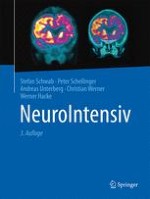Zusammenfassung
In Europa werden die Maßnahmen der kardiopulmonalen Reanimation gemäß der Empfehlungen des International Liaison Committee on Resuscitation (ILCOR) modifiziert nach den Leitlinien des European Resuscitation Council (ERC) durchgeführt. Auf Intensivstationen aller Fachrichtungen gelten für professionell ausgebildetes Personal insbesondere die erweiterten Maßnahmen der kardiopulmonalen Reanimation. Die hier dargestellten Empfehlungen orientieren sich an diesen Leitlinien, die für Standardsituationen entworfen wurden. In besonderen Situationen kann es von Vorteil sein, die beschriebenen Algorithmen zu verlassen, ein solches Vorgehen sollte jedoch immer begründet erfolgen. Sowohl auf Intensivstationen als auch auf peripheren Stationen sind Überlebensrate und neurologisches Ergebnis eines Herz-Kreislauf-Stillstandes insbesondere von einer guten Organisationsstruktur, dem Ausbildungs- und Trainingszustand des Personals, der Dauer des Kreislaufstillstandes und der elektrokardiographischen Manifestation abhängig.











